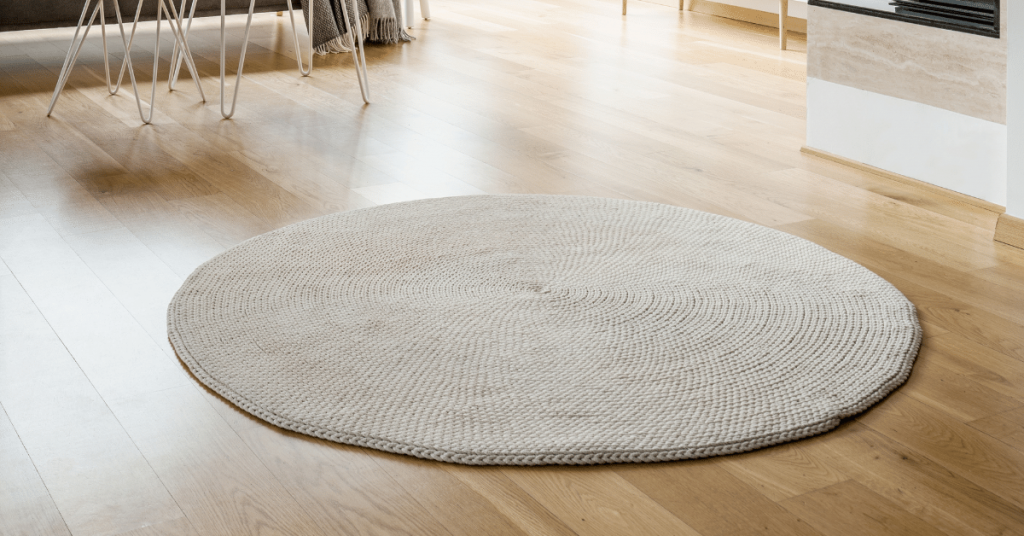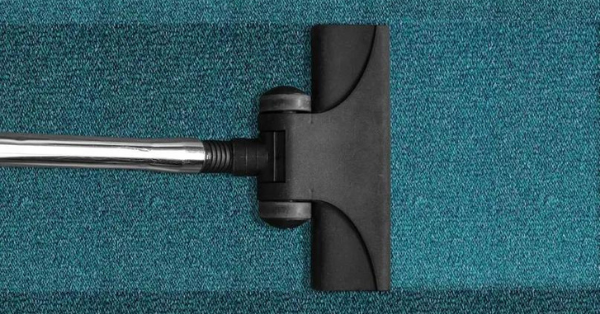The market is overflowing with durable and inexpensive polyester rugs. Yet health-conscious homeowners may refuse to get one for their home. The notoriousness of polyester as a toxic synthetic fiber could explain why that is so. However, is the material as harmful as people believe it to be? This article provides the perfect opportunity to learn more about this matter.
Polyester is a toxic rug material because it emits dangerous gases. Therefore, homes with babies, children, or allergy-sufferers should keep no products made of polyester. Even though it is an economically priced and aesthetic option, it should still be avoided. If you’re buying a new rug, you should consider ones made with natural fibers like wool, jute or seagrass.

We’d love for you to learn how to fulfill your carpeting needs with confidence. So if you’re interested in knowing more about different fibers, we would strongly recommend that you read the following guide.
So let’s dive right in and learn more about polyester!
Everything About Polyester
The nature of polyester makes it an ideal material for use in the textile and home decor industry.
Polyester is a non-renewable fiber derived from petroleum. If you visit the market, you will find innumerable rugs made from this material. Some are even bound to catch your eye with their enchanting colors. However, since they are made with a synthetic material, you might feel uneasy about the idea of keeping them at home.

The long-chain polymers of polyester come in existence in controlled artificial settings. Understanding the behavior of this material will enable you to make an effective decision for your home.
Generally, polyester inflicts harm to the environment in four different ways:
- Production happens through a carbon-intensive chemical process.
- Material is non-biodegradable
- Plays a significant role in microplastic pollution
- Emits volatile organic compounds (VOCs).
Let’s look at the whole picture to understand polyester better!
Carbon Intensive Production
The production of polyester is toxic to the environment.
If the environment is dear to you, refrain from getting a rug made of polyester.
The creation of polyester is dependent on fossil fuel extraction. Therefore, it has a high carbon footprint, and it dramatically damages the environment. During operations, a factory can emit substantial amounts of greenhouse gases, thereby contributing to global warming. These emissions pollute the environment and potentially trigger respiratory illnesses like asthma.
If you’re the sort of person who can’t bear to pollute the world, the choice is clear. Buying a polyester rug is out of the question.
Non-Biodegradable Nature
When it comes to decomposing, polyester is the worst fabric out there!
Polyester cannot naturally break down or decompose. According to estimates, polyester can take from 20 years to 200 years to decompose on its own. Therefore, it is a noteworthy vector of pollution. The non-biodegradable nature of polyester only adds to the damages this fiber causes.
WARNING
IF YOU LOVE MARINE LIFE, ABANDON POLYESTER AS QUICKLY AS YOU CAN.
Polyester has a massive impact on microplastic pollution. This material is a major source of microplastic fibers in the ocean, which is toxic to marine life. Do your best to eliminate this synthetic fiber as much as you possibly can from your life.

This manufactured fiber has an overarching negative impact on the ecosystem. It is involved in causing issues like oil spills, wildlife disruption, and biodiversity loss.
Detrimental for Vulnerable Groups
The presence of a polyester rug ensures poor indoor air quality.
According to the Environmental Protection Agency, indoor air quality is generally two to five times worse than that of the outdoors. This revelation is distressing as Americans spend approximately 90 percent of their time there! If that isn’t a recipe for a human health disaster, then what is?
Toxic chemicals are in the DNA of polyester.
Polyester can increase the risk of adverse health outcomes for:
- Babies and Children
- Allergy prone individuals like patients with respiratory illnesses

Polyester fibers release irritants in the environment called volatile organic compounds. These chemicals are stored within the material and have the ability to volatilize. In other words, after a long period has passed, the compounds stored in the fibers evaporate. It is worrying that emissions can negatively impact the health of those who are indoors.
Babies and children are at risk of increased illness due to their developmentally immature immune system. Naturally, parents should be unwilling to take any risk when it comes to their offspring. It’s best to keep products made from polyester away from the little ones!
Individuals with illnesses like asthma or sinusitis are sensitive to dips in the indoor air quality. They will feel the harsh impact of irritants in their surroundings. Therefore, it is no brainer that their homes need to stay away from polyester.
Mediocre Longevity
Polyester isn’t the best candidate if you want your rug to last long!
Prolonged exposure to heavy footfall will wear down a polyester rug in about five years. This lifespan is lesser than that of floor coverings made of natural fiber, which can last for about fifteen years.
WARNING
SALESPEOPLE MAY WANT TO TRICK YOU INTO BUYING A PRODUCT WITH A POLYESTER-NYLON BLEND.
When you are shopping, salespeople will deceive you into purchasing a rug with a polyester-nylon blend. Don’t buy into their claims that ‘it has a greater lifespan than the ones made with pure nylon’.
Did you know some of the most appealing and vibrant colored rugs have polyester in them? But regardless of how good these rugs look, you shouldn’t consider them if they’re toxic.

Longevity isn’t polyester’s strong suit. So if that is your main priority, don’t consider this synthetic fiber. While this synthetic material is extensively in use in the textile and home decor, it isn’t the most long-lasting.
Resilience and Shape Retention
In matters of resilience and shape retention, polyester loses to other contenders. Once the polymers are damaged, they will remain flattened permanently. Therefore, you should avoid placing it in high-traffic areas unless you’re okay with replacing it soon.
Restoring polyester rugs to their original glory is a herculean task.
Apart from that, you must also be wary of placing furniture on top of a polyester rug. The synthetic fiber doesn’t respond kindly to furniture compression.

To trigger the release of volatile organic compounds, polyester rugs need some form of energy. So stepping over it will lead to the emission of irritants and pollutants. While you can’t see these substances in the atmosphere, they are out there to harm you!
What Other Options Are Available?
Polyester is a toxic synthetic material that has no place in your home. The safest materials for your rugs are natural fibers.
Here are the fiber options you can consider for your rug!
Wool
Soft, fluffy, and sustainable is the best way to describe wool.
Wool is a sophisticated and sublime material that is bound to amaze you. While it falls on the more expensive side, it has admirable qualities, which makes it worth every penny. Wool is extremely durable, hypoallergenic, fire-resistant, and eco-friendly. Moreover, it has somehow become a symbol of luxury.

PRO TIP
CONSISTENTLY CATER TO THE MAINTENANCE NEEDS OF YOUR WOOL RUG
To keep your floor covering in pristine condition, don’t forget to take consistent care of it. Regularly vacuum it before it is full of dirt. Don’t be careless with your floor coverings as you are likely to regret it.
The finishing touch of a wool rug can enhance the entire look of a room. Not only is it beautiful, but it will also last for more than a decade if properly maintained! So if you’re interested in making your home look more classy, place your bets on a wool rug!
Seagrass
A seagrass rug will never disappoint you with its calming flair.
Seagrass is a strong, durable natural fiber that doesn’t absorb water! So if anything spills on it, all you have to do is wipe it away. This washability allows you to keep the rug in mint condition. Additionally, it doesn’t attract dust or static, which further helps with maintenance.
If having an allergy-free surrounding is necessary for you, then don’t hesitate to get a seagrass rug.
This elegant seagrass carpet also falls on the expensive side. However, it delivers in both aesthetic and practical measures. The neutral tones of this material can make any room look stunning. And the hypoallergenic nature of this material can make people feel safe.
Conclusion
Polyester is pleasing to touch and delightful to see, but unfortunately, it is also toxic for health. So don’t keep a rug made of this synthetic material, unless you’re a fan of poor indoor air quality. Instead, consider more natural and sustainable options like wool and seagrass.
Everything about polyester from the production to the non-biodegradable nature harms the ecosystem. It can trigger adverse health outcomes and endanger marine life. If you feel like you are ethically responsible for protecting the environment, avoid this synthetic fiber.
If you wish to buy a rug online that is safe to keep indoors, get natural fiber floor coverings. We have a post that covers precisely the best online shops to buy rugs online. Check it out here!
